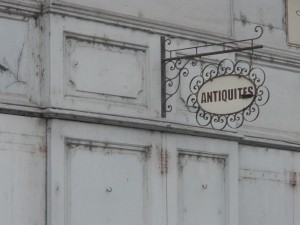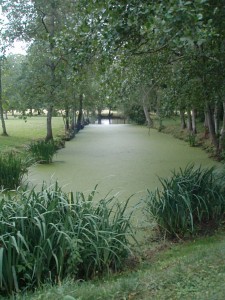Antoinette’s house was in the middle of fields of sunflowers and vines. Down a track, under a walnut tree, through tall metal gates and into a wild garden with barn, apricot tree, hollyhocks and, amongst the flowers and foliage, hidden places with tables and chairs. The tufa stone house was built in the 15th century, a 16th century addition to one side and a 17th century addition to the other. Antoinette welcomed me into a large communal room with flagstone floor and a large stone fireplace. My own room was tiny, cosy and tucked in the attic with a floor level window looking over the hollyhocks. I was charmed with the place, with Antoinette and her partner Adrian. With wild curly hair and round glasses, Adrian was perpetually ready to discourse and generally aimed provoke.
I spent three gloriously peaceful evenings out in their garden, warm in the last of the sun – only the wings of a wood pigeon or a goat’s bell to interrupt the stillness. Breakfasts were around a long farmhouse table with plenty of good humour – plus an abundance of marvellous apricot clafouti (apricots from the garden, nothing like the dry, chalky fruit often found in supermarkets).
As the sole English person there I was a target for Adrian’s good natured teasing. Oh les anglais and their superiorité… he began. “But are not the French perhaps renowned for their arrogance?” I returned with a smile. Up came the shoulders, the lips pursed and the hands opened in great expressiveness and out came the emphatic rejoinder: “Mais les francais sont d’une modesté………” We all enjoyed ourselves very much.
I visited Azay le Rideau and wandered slowly in the grounds of the chateau, gazing on the chateau and its reflection in the Indre river  before going inside. The one antique in Azay shop was very closed, but it was a pretty place, bridges decked with flowers and generally full of French appeal. I was not going to be able to see all the chateaux I wanted to visit that day – Ussé, La Chatonnierre – but instead founding myself stopping en route at the chateau de l’Islette, originally on a small island by the Indre. “If you hurry you can join the next tour” said the man selling tickets. Over the footbridge and into the parc. By the main door was a small gathering of people waiting for the guide. The chateau was still a family home and open only for two months in the summer. It had been the lover’s retreat of Rodin and Camille Claudel before things began to go very wrong. (The film “Camille Claudel” is gripping and tragic). The guide read us a poignant letter from Camille to Rodin. It was such a lovely afternoon and a Buvette with tables, chairs and bright cushions was set out at the water mill.
before going inside. The one antique in Azay shop was very closed, but it was a pretty place, bridges decked with flowers and generally full of French appeal. I was not going to be able to see all the chateaux I wanted to visit that day – Ussé, La Chatonnierre – but instead founding myself stopping en route at the chateau de l’Islette, originally on a small island by the Indre. “If you hurry you can join the next tour” said the man selling tickets. Over the footbridge and into the parc. By the main door was a small gathering of people waiting for the guide. The chateau was still a family home and open only for two months in the summer. It had been the lover’s retreat of Rodin and Camille Claudel before things began to go very wrong. (The film “Camille Claudel” is gripping and tragic). The guide read us a poignant letter from Camille to Rodin. It was such a lovely afternoon and a Buvette with tables, chairs and bright cushions was set out at the water mill.  Just as I finished walking by the river, thunder clapped and rain pelted down. The few people around scattered and I stood under a tree breathing in the atmosphere in the fragrant air.
Just as I finished walking by the river, thunder clapped and rain pelted down. The few people around scattered and I stood under a tree breathing in the atmosphere in the fragrant air.
Heading back to Chinon the sun reappeared and I went to pick up the shutters from Martine. She was talking to a friend outside her shop and he helped me load them into Sylvie. “Christian is also a brocanteur,” she said. “He will open up his shop for you, just follow his car.” So we drove along the river into a residential part of town. His brocante was in an old tiled butcher’s shop. “I’m usually closed on Wednesday afternoons” said Christian as he pushed up the metal shutters. He went on to tell me the story of how he came to be there and that he was from a family of wine growers. So after I bought some champagne crates and a watercolour of a 19th century house with formal gardens, Christian invited me to taste some of the wine he had stored in the shop. (Bottles were stacked three rows deep and floor to ceiling). He helped me take my purchases out to Sylvie, along with a couple of cases of wine.






1 Comment
Add Yours →Hi Gilli,
Once again your wonderful, expressive tales of yet another trip to France have brightened up my day. How envious I am of your life-style and business. Please keep on writing your blog as it is a real tonic.
Best wishes.